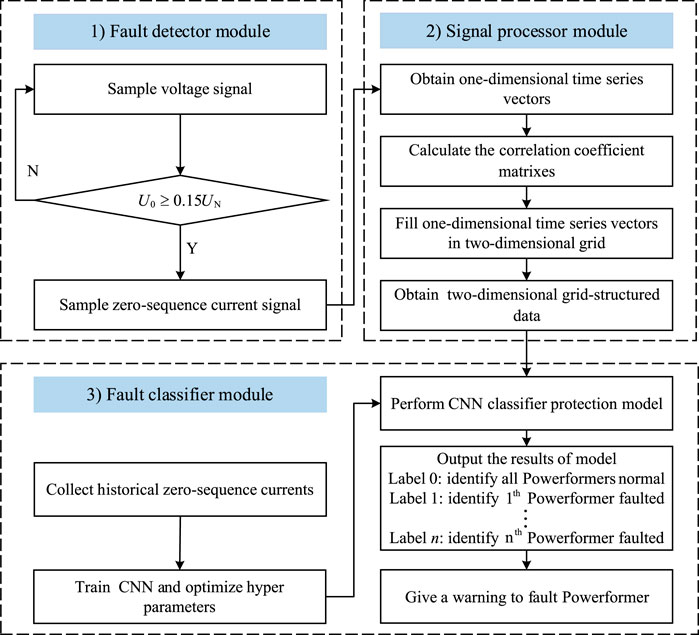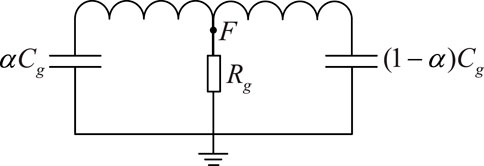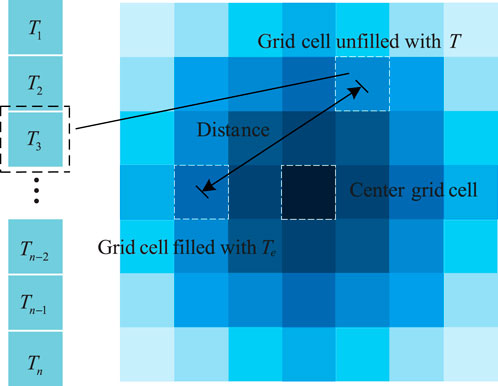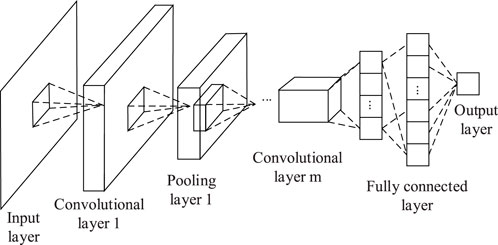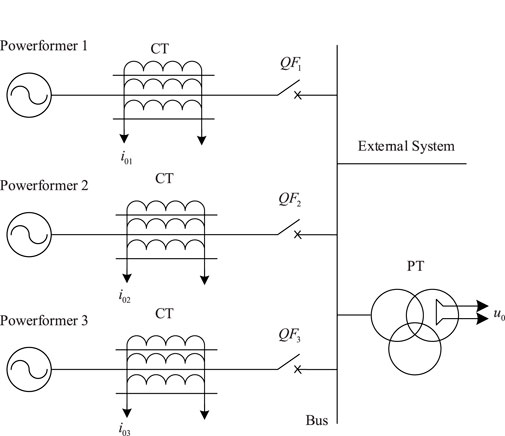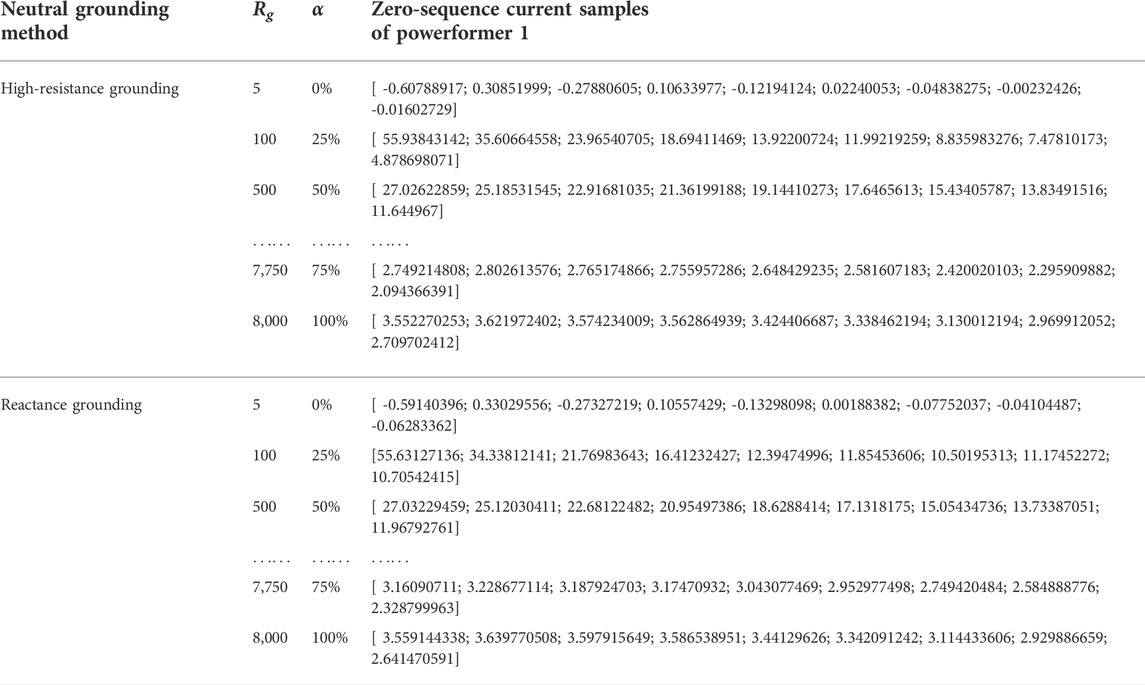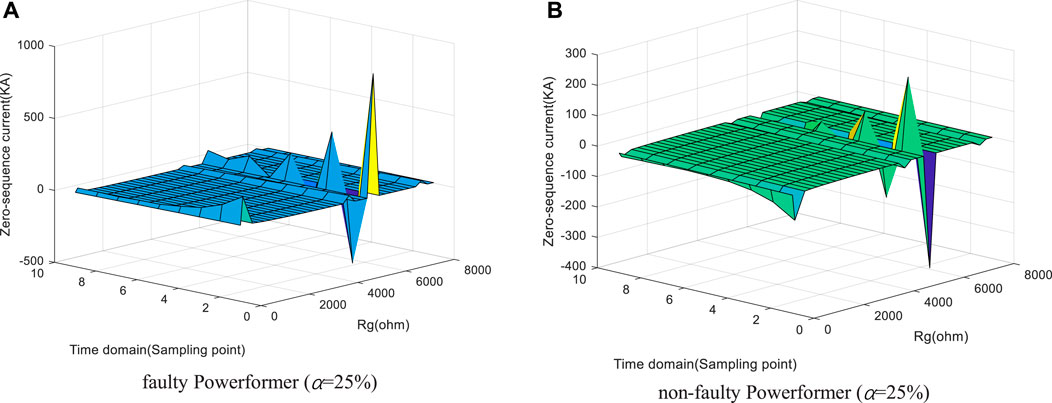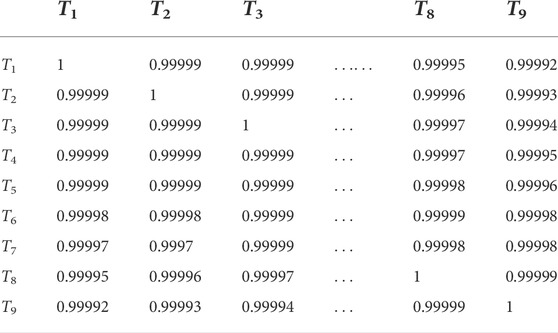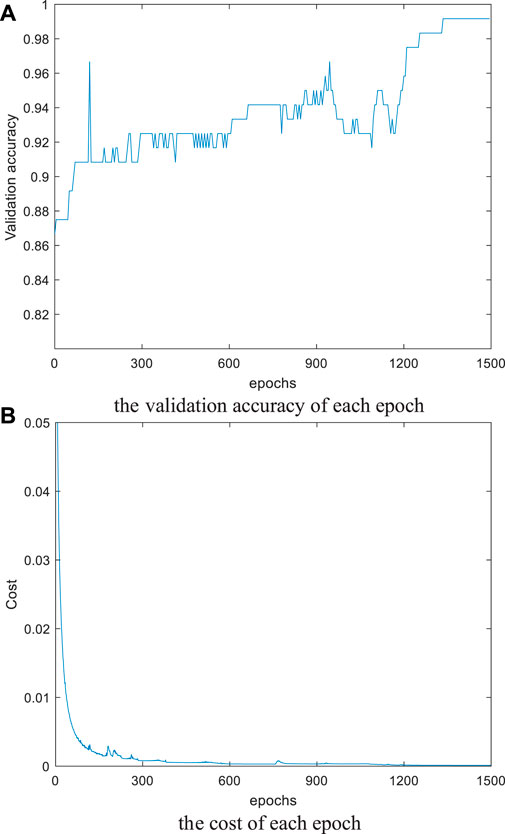- 1School of Electrical and Information Engineering, Changsha University of Science and Technology, Changsha, Hunan, China
- 2China Electric Power Research Institute (CEPRI), Beijing, China
- 3Xiangtan Electric Co., Ltd. Hualian, Xiangtan, Hunan, China
It is necessary for powerformers running in parallel to identify which powerformer occurs at the stator single-line-to-ground (SLG) fault. Some state-of-the-art fusion discriminations are used to identify stator SLG fault, but these methods extract fault features artificially, and application conditions are limited. Convolutional neural network (CNN) has shown superior automatic feature extraction ability in various fields, but it cannot directly extract features from one-dimensional time series vectors collected by powerformers. Therefore, this article proposed a novel SLG fault protection scheme based on the hub-and-spoke grid data converting algorithm (HSGC) and CNN. First, Pearson product-moment correlation coefficients (PCCs) are used to calculate the correlations of one-dimensional time series vectors, establish a correspondence between them and the distance of two-dimensional grid cells, and then convert one-dimensional time series vectors to two-dimensional grid-structured data by HSGC. Second, the trained CNN automatically extracts the features of two-dimensional grid-structured data. Finally, the faulty powerformer can be identified based on the output of CNN. The proposed protection scheme is verified through the simulation of ATP-EMTP and Python. The results show that the scheme can accurately detect a faulty Powerformer under different conditions where neutral point is high-resistance or reactance grounding, even if fault resistance is 8,000 Ω.
1 Introduction
High-voltage equipment used in power generation is continuously being developed in order to reduce production costs, improve efficiency, and, more recently, minimize environmental impact (Tzelepis et al., 2020; Zhou et al., 2022). Over the past decades, a series of changes have taken place in high-voltage apparatus. One of them is the powerformer (Leijon, 1998), a new type of generator developed by ABB with a stator winding made up of cross-linked polyethylene (XLPE) cable (Shi et al., 2021). The cross section of the XLPE cable is a circular winding, which can avoid uneven electric field distribution along the conductor surface caused by the shape of rectangular stator bars of the conventional generator (Wang et al., 2020a), allowing the output voltage at the terminal of powerformer to exceed about 30–35 kV and reach theoretical levels of 400 kV. Thus, it can be directly connected to the power transmission systems, which leads to lower power losses.
The stator SLG fault is the most potential harm, and it is the most frequent fault that generators will experience (Xue et al., 2022; Huang and Jia, 2017). Especially for powerformers, because of the XLPE cable with greater capacitance to ground, the fault current is greater and the damage to the powerformer is greater after the stator SLG fault occurs. Meanwhile, the stator SLG fault is very likely to develop into a more severe inter-turn fault and phase-to-phase fault, leading to the damage of stator core and stator winding of powerformers and seriously affecting the safe and stable operation of the power grid. To avoid such consequences, reliable detection and isolation of stator SLG fault have become essential for powerformers.
For a group of generators running in parallel, if an SLG fault occurs on a generator, it is necessary to selectively detect the faulty generator. Several selective protection methods for detecting stator SLG fault of powerformers have been proposed. Wang et al. (2013a) proposed using the direction and the magnitude of leakage current as identification criteria to detect the SLG fault and combining the fundamental component and the third-harmonic component of leakage current to realize 100% coverage of fault detection. However, the protection criteria were analyzed separately, and the reliability was low. To address this problem, some protection methods based on fault feature fusion have been proposed in the study by Wang et al. (2013b). Wang et al. (2013c) proposed a stator SLG fault protection scheme based on a fuzzy clustering algorithm and hierarchical clustering algorithm, which synthesizes several fault features to calculate cluster centers and then compares the distance between the detected pattern and two cluster centers to identify the faulty powerformer. Also, Fang et al. (2020) further proposed a stator SLG fault protection scheme for powerformers based on multi-dimensional information fusion. They used the discriminant analysis method to synthesize four fault features and discriminated the faulty powerformer by comparing the Manhattan distance between fault features. Even though these methods extracted fault features artificially, their application conditions were limited.
CNN is a successful algorithm of deep learning that has been widely used in multiple fields, especially in digital image processing, face recognition, audio retrieval, and other fields (Abdalla et al., 2019; Liu et al., 2019; Rajeev et al., 2019; Klompenburg et al., 2020; Roneel et al., 2021). CNN solves the dilemma that other algorithms need to artificially extract features. Also, it finds the optimal weight parameters matrix by error back propagation along with local connections and weight sharing based on correlation between data (Zhang et al., 2019), which can automatically extract abstract and valuable features from the data to complete specific tasks (Hao et al., 2022; Huang et al., 2021). Applying CNN to powerformer protection has the potential to achieve good results.
Considering that “the simpler the information, the more reliable the relay protection result”, the simplest case of the data collected by powerformer’s protection method is a one-dimensional time series vector, and there is a strong correlation between the data. CNN can only process multi-dimensional data (Liu et al., 2020) and cannot process one-dimensional time series data collected by powerformer. In order to accurately identify, which Powerformer has stator SLG fault in parallel operation, and use CNN with powerful automatic feature extraction capability to process one-dimensional time series vectors, this article proposes a data dimension transformation method based on HSGC and then uses CNN to implement powerformer stator SLG fault protection. Section 2 introduces the main modules and the framework of the proposed protection scheme. Section 3 explains the physical model of powerformer, sample set acquisition, fundamental theories of HSGC, and the protection principle. Section 4 shows the results of the ATP-EMTP and Python simulation and compares between the proposed protection scheme and other protection schemes.
2 General protection scheme
Basically, the protection scheme proposed in this article is divided into the following three modules: the fault detector module, the signal processor module, and the fault classifier module. A general protection scheme is shown in Figure 1.
2.1 Fault detector module
The zero-sequence voltage can be measured by the voltage transformer connected to the terminal of Powerformer. The effects of zero-sequence fundamental and third-harmonic voltages are eliminated by setting the reliable pickup of the overvoltage relay, which is the sum of zero-sequence fundamental voltage and zero-sequence harmonic voltage (15% phase voltage). When the zero-sequence voltage is detected to be greater than or equal to the pickup, the protection is activated, and then the zero-sequence currents can be measured by the current transformer connected to the terminal of Powerformer; conversely, it returns.
2.2 Signal processor module
First, if the fault detector protection is activated, the one-dimensional time series vectors, which consist of zero-sequence currents, are input to the signal processor module. Second, one-dimensional time series vectors are converted into two-dimensional grid-structured data by HSGC. Concretely, in order to reflect the correlation information of the one-dimensional time series vectors, the correlation coefficient matrixes of the one-dimensional time series vectors are calculated using PCCs. According to the correlation coefficient matrixes and the spatial neighborhood correlation of grid cells, the one-dimensional time series vectors are converted into two-dimensional grid-structured data. Finally, the two-dimensional grid-structured data was used as input to the fault classifier module.
2.3 Fault classifier module
In the fault classifier module, the historical zero-sequence currents of each powerformer are collected under normal or fault conditions when n powerformers are running in parallel. The collected zero-sequence currents are divided into n+1 classifications. The zero-sequence currents are classified into one class when all powerformers are in a normal state, and the zero-sequence currents are classified into class n when the stator SLG fault occurs on the nth powerformer. After converting these zero-sequence currents into two-dimensional grid-structured data separately, they are fed into the CNN classifier protection model to train it and optimize hyper-parameters. After training, the CNN classifier protection model can be used to identify the classification of two-dimensional grid-structured data and then accurately identify the faulty powerformer. If the stator SLG fault occurs on one of the powerformers running in parallel, this module starts and gives an alarm according to the output of the CNN classifier, so that maintenance personnel can take actions to reduce the loss caused by the fault. If the powerformers are all running normally, the results can be recorded and used as a reference for subsequent research.
3 Protection principle
3.1 Powerformer equivalent model and sample set acquisition
Establish an equivalent model for Powerformer. Since the Powerformer winding uses graded insulation (there are no linear relations between the ground capacitance of stator winding and turns) (Lin et al., 2018), the Powerformer cannot simply apply the equivalent model of conventional generators. When the stator SLG fault occurs on the Powerformer, this article equates the total ground capacitance Cg of one phase of the stator winding into two parts: one portion αCg of the total ground capacitance from the neutral point to the fault location of the winding, while the rest (1-α)Cg of the total ground capacitance from the fault location to the powerformer terminal winding (Wang et al., 2020b; Tian et al., 2007). Then, the terminal voltage and the established equivalent capacitance are used to calculate the zero-sequence capacitance current when the powerformer is at fault. The equivalent phase-to-ground capacitance of each phase winding of the powerformer is shown in Figure 2.
After the stator SLG fault occurs on the Powerformer, the zero-sequence current of powerformers operating in parallel is measured. Also, the samples of zero-sequence currents measured from each Powerformer compose a one-dimensional time series vector.
The original data matrix T consists of one-dimensional time series vectors, which can be defined as follows:
where n represents the number of powerformers operating in parallel, and m represents the number of zero-sequence current samples from each powerformer. Define each row of the original data matrix T as a one-dimensional vector Ti with n quantities.
3.2 Hub-and-spoke grid data converting algorithm
In order to take advantage of CNN, it is necessary to convert one-dimensional time series vectors into two-dimensional grid-structured data that can be directly processed by CNN. This section introduces the HSGC proposed in this article, which can increase the dimensionality of one-dimensional time series vectors.
The relative positions and distances between two-dimensional grid cells can be used to describe the spatial neighborhood relations between grid cells, that is, the correlation between two-dimensional grid cells. The correlation is strongest for neighborhood grid cells and weakest for grid cells at diagonal vertices. Correspondingly, one-dimensional time series vectors also have strong correlations. Therefore, the correlation between two-dimensional grid cells can be used to reflect the correlation between one-dimensional vectors.
Based on the above mentioned correlation, in order to increase the dimension of one-dimensional time series vectors, this article first determines a one-dimensional vector to fill the center cell of the two-dimensional grid and then radially fills the remaining one-dimensional vectors into the unfilled two-dimensional grid cells one by one. Specifically, in order to fill the one-dimensional vector with the strongest correlation into the geometrical center cell of the two-dimensional grid, the two-dimensional grid should be a square with b×b cells (b is odd, b > 1, and b×b = m) because the square has one and only one center grid cell, which meets the requirements of this article. The number of zero-sequence current samples should be consistent with the number of cells of the two-dimensional grid so that each one-dimensional vector Ti can be mapped to the cell of the two-dimensional grid one by one, and the spatial neighborhood relations of the grid cells can well reflect the implicit correlation information of the one-dimensional vectors.
3.2.1 Center grid cell selection strategy
The grid cell at the geometrical center of the square two-dimensional grid has the strongest overall correlation. Since the one-dimensional vector Ti is mapped to the grid cell one by one, the one-dimensional vector with the strongest overall correlation is selected and then filled into the center grid cell. The PCCs of the one-dimensional vectors are applied to describe the correlation between them. The equation is as follows:
where Corr (Ti,Tj) represents the variances of the one-dimensional vectors Ti and Tj, σi and σj represent the standard deviation of the one-dimensional vectors Ti and Tj, respectively. The PCCs between m one-dimensional vectors are calculated by (2) to build an m×m correlation coefficient matrix. The sum of each row of the matrix is defined to represent the overall correlation of the corresponding one-dimensional vector. The greater the sum of PCCs of a one-dimensional vector, the stronger its overall correlation.
3.2.2 Rest cells’ selection strategy
The rest of the grid cells are filled radially outward from the center grid cell. The filling order is based on the correlation of one-dimensional data, that is, the spatial neighborhood relation of the two-dimensional grid. Based on the relative distance between the unfilled grid cell and all filled grid cells, we select the one-dimensional vector with the largest score and fill it into the corresponding grid cell each time. The specific score rule is shown in Eq. 3.
3.2.3 Score rule
When filling the one-dimensional vectors into the rest of the grid cells, the average of the PCCs weighted by the relative distance is defined as the score rule for the rest cells’ selection strategy.
The set of one-dimensional vectors filled into the grid is Q, the set of the rest of one-dimensional vectors unfilled into the grid is P, and the unfilled grid cell is defined as A; let Ae be the grid cell filled with the one-dimensional vector Te. For any one-dimensional vectors
where Dist (A,Ae) is the length of the connection of the geometrical center between grid cells A and Ae (the relative linear distance between them).
The score(T) of the rest of the one-dimensional vectors is calculated by Eq. 3, and the one-dimensional vector with the largest score(T) is selected to fill the grid cell A.
Figure 3 shows the schematic diagram of the HSGC, in which the depth of the grid cell filling color represents the priority of the filling order. The darker color of the grid cell is filled first.
3.3 Powerformer protection principle
The basic idea of identifying faulty Powerformer with the help of CNN is to perform hierarchical processing on image data, which is two-dimensional grid-structured data in this article, to extract features autonomously, to fuse features at the high level of the network, and to complete the classification task of stator SLG fault in Powerformer. Specifically, in order to identify the faulty Powerformer, the two-dimensional data converted from one-dimensional vectors are used as the input of CNN, and then the CNN autonomously extracts key information and features from it through multiple convolutions and pooling operations (Ren et al., 2020). These key information and features are fed into a fully connected layer. Also, the overall information can be obtained after fusing key information and features at the fully connected layer. The output layer outputs the classification labels of powerformers based on the overall information. Finally, the faulty powerformer is determined corresponding to the classification label, and the classification task of CNN is completed.
Define
where x is the receptive field of sample y (Zhang et al., 2022), and the size of both the convolution kernel k and the receptive field x is p.
The pooling layer applies subsampling to extract key information and features and ensure the invariance of them (Chang and Shen, 2021). After multiple convolutions and pooling operations, the key information and features are used as input to the fully connected layer to obtain overall information, which is used to obtain the probability distribution [ g0, g1,……, gn-1, gn] that the sample belongs to each class (g0 is the probability of all powerformers being in a normal state, and gn is the probability of nth powerformer being in a fault state). The protection criterion is as follows:
If g0 = max{g0, g1,……, gn}, all powerformers are in normal situation, and the output label is 0; if g1 = max{g0, g1,……, gn}, it means the stator SLG fault occurs on the Powerformer 1, and the output label is 1; ……; if gn = max{g0, g1,……, gn}, it means the stator SLG fault occurs on the Powerformer n, and the output label is n. The CNN classifier flow chart is shown in Figure 4.
4 Simulation verification and analysis
4.1 Simulation model
To test the reliability of the powerformer protection method, a simulation model of the stator SLG fault of powerformer was established by ATP-EMTP. A parallel system with three powerformers is taken as an example (fault started at 0.055 s). The model is shown in Figure 5. Specifically, the related parameters of the model are as follows: the rated voltage UN of powerformers 1–3 is 150 kV; the rated frequency fN is 50Hz; the winding ground capacitances Cg1, Cg2, and Cg3 per phase is 0.555, 0.5574, and 0.555 μF, respectively; the ground capacitance Ct per phase of the external system is 0.15 μF; the inception angle is
Figure 6 shows the zero-sequence voltage and zero-sequence current of powerformers when the SLG fault occurs at 0.055 s. When the Powerformer operating in parallel occurs at a stator SLG fault, zero-sequence voltage and zero-sequence current components will be measured by the fault detector module. If U0 ≥ 0.15UN, the protection is activated.

FIGURE 6. Zero-sequence voltage and zero-sequence current of powerformers when the SLG fault occurs at 0.055 s.
4.2 Simulation analysis
This section presents the experimental results which are performed on the parallel system with three powerformers. To increase the diversity of samples and to evaluate the efficiency of fault detection, the fault conditions, including the transition resistance, fault location, and neutral grounding method of the powerformers, were tested. The obtained data are then fed into a Python code which executes the protection scheme proposed by this article according to the block diagram in Figure 1.
Table 1 shows the one-dimensional time series vectors under different fault conditions (only partial data of Powerformer 1 is listed). In this simulation, a two-dimensional grid has nine cells (b = 3 and m = b×b = 9). So, the one-dimensional time series vectors are composed of the first nine current sampling samples after the stator SLG fault occurs. A total of 3,813 one-dimensional time series vectors, which are the zero-sequence current samples, are obtained as the sample set. Specifically, 960 one-dimensional time series vectors are obtained from cases where all powerformers are in a normal situation, and 2,853 one-dimensional time series vectors are obtained from cases where a stator SLG fault occurs on one of the powerformers running in parallel under different fault conditions.
Figure 7 shows the variation of zero-sequence currents with time under different fault conditions. It has been found from the figure that the amplitude of zero-sequence currents of the powerformer changes smoothly under most fault conditions, while it changes drastically only in few cases. Also, the zero-sequence currents of faulty and non-faulty powerformers have similar trends over time in most cases. CNN is used to avoid the dilemma of artificial feature extraction and automatically extract features from zero-sequence currents.
Table 2 shows some data from the correlation coefficient matrix of one sample. Since the zero-sequence currents of the parallel system with three powerformers are sampled nine times at equal time intervals, nine one-dimensional vectors with three components (each representing a powerformer) can be obtained. The PCCs between each of the nine one-dimensional vectors are calculated to obtain 1,271 correlation coefficient matrixes of the sample set. According to the correlation coefficient matrixes of the sample set and the selection strategy of HSGC, the one-dimensional vectors of the sample set are converted to obtain 1,271 × 3 × 3 two-dimensional grids. Each cell in the two-dimensional grid is mapped to the one-dimensional vector one to one, and the spatial adjacent relationship between the grid cells can reflect the correlation information between the one-dimensional vectors well. At the same time, two-dimensional grid-structured data can be used as input to the CNN classifier protection model.
Figure 8 shows the validation accuracy and cost of the CNN model; 90% of the two-dimensional grid-structured data is used as the training set, and the remaining 10% is used as the test set. By inputting the training set into the CNN classifier protection model, it can be found that the model has high validation accuracy, low cost, and stable results.
Table 3 shows the results of feeding the test set into the trained CNN classifier protection model (due to the one-hot algorithm, the probability is only zero and one). Label 0 represents all powerformers that are in a normal situation; Label 1 represents the 1st Powerformer that occurs at the stator SLG fault; Label 2 represents the 2nd Powerformer that occurs at the stator SLG fault; Label 3 represents the 3rd Powerformer that occurs at the stator SLG fault. The simulation results show that the faulty powerformer can be accurately identified by the protection scheme based on the HSGC and CNN proposed in this article.
4.3 Comparative analysis of algorithms
A comparison between the proposed protection scheme and the other existing protection schemes of multi-dimensional fusion (Fang et al., 2020) and a protection scheme based on a fuzzy clustering algorithm (Wang et al., 2016) is conducted. The comparison results are shown in Table 4. The protection scheme of multi-dimensional fusion is not applicable when the neutral point is grounded by an arc suppression coil due to the compensation effect of the arc suppression coil on capacitance current; the fuzzy clustering algorithm experiences misclassification under the fault condition of powerformer 1 (5–50%) due to the influence of the initial clustering center selection caused by artificial feature extraction.
In contrast, the protection proposed in this article converts the one-dimensional time series vectors into two-dimensional grid-structured data, which can be processed directly by CNN. The protection scheme avoids the artificial selection of features. Meanwhile, since local connectivity and weight sharing of CNN are based on the correlation between input data, the protection scheme uses the spatial adjacent correlation between two-dimensional grid cells to retain the correlation information between one-dimensional vectors. CNN is used to automatically extract the features of one-dimensional time series vectors to discriminate whether the powerformer occurs at the stator SLG fault.
The simulation results show that the protection scheme proposed in this article is not affected by the system operation mode, and it can accurately identify the faulty Powerformer when the abovementioned two comparison methods cannot correctly identify the fault. The protection scheme based on HSGC and CNN can better realize the protection of parallel operation of powerformers with high accuracy, low cost, and stable results.
5 Conclusion
Some state-of-the-art fusion discriminations are used to identify which powerformer occurs at a stator SLG fault when they are operating in parallel, but these methods extract fault features artificially, and the application conditions are limited. A novel protection scheme based on HSGC and CNN has been developed in order to overcome these problems. Its specific advantages are as follows:
1) The protection model has superior automatic feature extraction capability and takes correlation information between one-dimensional data into account. The protection scheme has high validation accuracy, low cost, and stable results, which improves the reliability of stator SLG fault protection for powerformer.
2) Using the deep learning capabilities, strong generalization ability, and robustness of CNN, abstract and valuable features are automatically extracted from the zero-sequence current data to accurately identify which powerformer occurs at the stator SLG fault.
3) The protection model has a strong adaptive ability. There is no need to set the threshold, which can realize protection without a threshold. Also, the scheme is not easily affected by fault resistance, fault location, and neutral grounding mode. The protection scheme can be used to identify the faulty powerformer under different fault conditions.
Data availability statement
The raw data supporting the conclusion of this article will be made available by the authors, without undue reservation.
Author contributions
XL carried out the simulation and drafted the manuscript. YW designed the project and revised the manuscript. XL participated in the design of the study and performed the statistical analysis. YW and WL participated in its design and coordination. CC, BW, and JW revised the manuscript. All authors have read and approved the final manuscript.
Funding
This work was supported by National Natural Science Foundation of China (No. 52177069), Hunan Student Innovation Training Project (No. S202210536087) and Hunan Graduate Research and Innovation Project (No. CX20210795).
Conflict of interest
Authors BW and JW were employed by Xiangtan Electric Co., Ltd.
The remaining authors declare that the research was conducted in the absence of any commercial or financial relationships that could be construed as a potential conflict of interest.
Publisher’s note
All claims expressed in this article are solely those of the authors and do not necessarily represent those of their affiliated organizations, or those of the publisher, the editors, and the reviewers. Any product that may be evaluated in this article, or claim that may be made by its manufacturer, is not guaranteed or endorsed by the publisher.
Abbreviations
XLPE, cross-linked polyethylene; SLG, stator single-line-to-ground; CNN, convolutional neural network; HSGC, hub-and-spoke grid data converting algorithm; PCC, Pearson product-moment correlation coefficient.
References
Abdalla, Y., Tariq Iqbal, M., and Shehata, M. (2019). Convolutional neural network for copy-move forgery detection[J]. Symmetry 11 (10). doi:10.3390/sym11101280
Chang, M., and Shen, Y. X. (2021). Fault diagnosis strategy of a wind power bearing based on an improved convolutional neural network[J]. Power Syst. Prot. Control 49 (06), 131–137. doi:10.19783/j.cnki.pspc.200585
Fang, T., Zhou, Y., and Liao, W. P. (2020). A new discrimination of stator single-phase grounding fault based on multi-dimensional fusion for Powerformer[J]. J. Phys. Conf. Ser. 1633 (1), 1–7. doi:10.1088/1742-6596/1633/1/012113
Hao, H., Zhenhua, Z. H., Ziyi, Z. Y., Xu, X. X. Y., and Xu, Y. C. (2022). Insulator fouling monitoring based on acoustic signal and one-dimensional convolutional neural network. Front. Energy Res. 10, 906107. doi:10.3389/FENRG.2022.906107
Huang, S. F., and Jia, W. C. (2017). A new fault location method for stator single-phase ground fault in large turbine generator[J]. Power Syst. Prot. Control 45 (9), 35–40. doi:10.7667/PSPC161504
Huang, X. H., Li, Y. Y., and Chai, Y. (2021). Intelligent fault diagnosis method of wind turbines planetary gearboxes based on a multi-scale dense fusion network[J]. Front. Energy Res. 9, 747622. doi:10.3389/FENRG.2021.747622
Klompenburg, T. V., Kassahun, A., and Catal, C. (2020). Crop yield prediction using machine learning: A systematic literature review[J]. Comput. Electron. Agric., 177. doi:10.1016/j.compag.2020.105709
Lin, C., Wang, Y. Y., and Zeng, X. J. (2018). Stator single phase ground Fault protection of powerformers based on grading insulation[J]. Proc. CSEE 38 (23), 7052–7060+7139. doi:10.13334/j.0258-8013.pcsee.180189
Liu, C. Y., Wang, Q., and Bi, X. J. (2020). Research on rain removal method for single image based on multi-channel and multi-scale CNN[J]. J. Electronics&Information Technol. 42 (09), 2285–2292. doi:10.11999/JEIT190755
Liu, J. H., Chen, K. X., and Ma, J. (2019). Classification of three-phase voltage dips based on CNN and random forest[J]. Power Syst. Prot. Control 47 (20), 112–118. doi:10.19783/j.cnki.pspc.181337
Rajeev, R., Vishal M, P., HyperFace, C. R., and [J], (2019). A deep multi-task learning framework for face detection, landmark localization, pose estimation, and gender recognition. IEEE Trans. pattern analysis Mach. Intell. 41 (1). doi:10.1109/TPAMI.2017.2781233
Ren, H. Y., Hou Z, J., Bharat, V., Wang, H., and Pavel, E. (2020). Power system event classification and localization using a convolutional neural network[J]. Front. Energy Res. 8, 607826. doi:10.3389/FENRG.2020.607826
Roneel, S. V., Hao, X., and Shlomo, B. (2021). Benchmarking audio signal representation techniques for classification with convolutional neural networks[J]. Sensors 21 (10). doi:10.3390/s21103434
Shi, J. F., Ge, B. J., and Lv, Y. L. (2021). Analysis of excitation loss fault of cable winding asynchronous high-voltage generator[J]. Electr. Mach. Control 25 (03), 46–55+66. doi:10.15938/j.emc.2021.03.006
Tian, Q., Lin, X. N., and Liu, L. (2007). A novel self-adaptive compensated differential protection design suitable for the generator with considerable winding distributed capacitance. IEEE Trans. Power Deliv. 22 (2), 836–842. doi:10.1109/tpwrd.2007.893590
Tzelepis, D., Psaras, V., Tsotsopoulou, E., Mirsaeidi, S., Dysko, A., Hong, Q., et al. (2020). Voltage and current measuring technologies for high voltage direct current supergrids: A Technology review identifying the options for protection, fault location and automation applications. IEEE Access 8, 203398–203428. doi:10.1109/access.2020.3035905
Wang, Y. Y., Guo, Y. S., Zeng, X. J., Chen, J., Kong, Y., and Sun, S. (2020). Stator single-line-to-ground Fault protection for bus-connected powerformers based on S-transform and bagging ensemble learning. IEEE Access 8, 88322–88332. doi:10.1109/access.2020.2993692
Wang, Y. Y., Huang, X. C., and Zeng, X. J. (2020). Studies on stator single-line-to-ground faults protection for a Powerformer considering the winding electromotive force distribution[J]. Int. J. Electr. Power Energy Syst. 119©, 321–328. doi:10.1016/j.ijepes.2020.105940
Wang, Y. Y., Zeng, X. J., Dong, J. B. Z. Y., Li, Z. W., and Huang, Y. (2013). Studies on the stator single-phase-to-ground Fault protection for a high-voltage cable-wound generator. IEEE Trans. Energy Convers. 28 (2), 344–352. doi:10.1109/tec.2013.2240303
Wang, Y. Y., Zeng, X. J., and Huang, Z. Y. (2013). Novel protection scheme of stator single-phase-to-ground fault for powerformers. Int. J. Electr. Power & Energy Syst. 53 (1), 321–328. doi:10.1016/j.ijepes.2013.05.010
Wang, Y. Y., Zeng, X. J., Xu, Z. Y. Y., Yuan, J., and Huang, Y. (2013). Stator single-phase-to-ground Fault protection for bus-connected powerformers based on hierarchical clustering algorithm. IEEE Trans. Energy Convers. 28 (4), 991–998. doi:10.1109/tec.2013.2281491
Wang, Y. Y., Zhou, J. M., Wei, G., Dong, Z., and Chen, H. (2016). Stator winding single-phase grounding faults protective scheme based on discriminant analysis for Powerformers with selectivity. Int. J. Electr. Power & Energy Syst. 77 (1), 145–150. doi:10.1016/j.ijepes.2015.11.037
Xue, L., Sun, G. H., and Wang, X. H. (2022). Novel location method for stator single-phase grounding fault of large non-salient pole generator[J]. Electr. Power Autom. Equip. 42 (1), 221–224. doi:10.16081/j.epae.202109023
Zhang, D. H., Zhang, X. W., Sun, H., and He, J. H. (2022). Fault diagnosis for AC/DC transmission system based on convolutional neural network[J]. Automation Electr. Power Syst. 46 (05), 132–145. doi:10.7500/AEPS20210201006
Zhang, Q., Wang, J. P., and Li, W. T. (2019). Insulator state detection of CNN based on feedback mechanism[J]. Trans. China Electrotech. Soc. 34 (16), 3311–3321. doi:10.19595/j.cnki.1000-6753.tces.180962
Zhou, H. Y., Yao, W., Ai, X. M., and Li, D. H. (2022). Comprehensive review of commutation failure in HVDC transmission systems[J]. Electr. Power Syst. Res., 205. doi:10.1016/j.epsr.2021.107768
Nomenclature
Variables Cg total ground capacitance of one phase of the stator winding
α location of the stator winding grounded
Ti ith one-dimensional vectors of the original data matrix T
n number of powerformers operating in parallel
m number of zero-sequence current samples
σi standard deviation of the one-dimensional vector Ti
Ae grid cell filled in the one-dimensional vector Te
p size of the convolution kernel and receptive field
g0 probability of all powerformers being in a normal state
gn probability of nth powerformer being in a fault state
u result of the output of CNN
Rg ground fault resistance.
Sets
Q set of one-dimensional vectors filled into the grid
P set of one-dimensional vectors unfilled into the grid
Y set of the two-dimensional grid-structured data samples.
Keywords: powerformer, single-phase-to-ground fault protection, HSGC, CNN, PCCs
Citation: Liu X, Wang Y, Luo X, Cao C, Li W, Wang B, Wang J and Wang Y (2022) Stator single-line-to-ground fault protection for powerformers based on HSGC and CNN. Front. Energy Res. 10:998797. doi: 10.3389/fenrg.2022.998797
Received: 20 July 2022; Accepted: 05 August 2022;
Published: 06 September 2022.
Edited by:
Lipeng Zhu, Hunan University, ChinaCopyright © 2022 Liu, Wang, Luo, Cao, Li, Wang, Wang and Wang. This is an open-access article distributed under the terms of the Creative Commons Attribution License (CC BY). The use, distribution or reproduction in other forums is permitted, provided the original author(s) and the copyright owner(s) are credited and that the original publication in this journal is cited, in accordance with accepted academic practice. No use, distribution or reproduction is permitted which does not comply with these terms.
*Correspondence: Yuanyuan Wang, eXVhbnl1YW4ud2FuZy4xOTgwQGllZWUub3Jn
 Xiaohan Liu
Xiaohan Liu Yuanyuan Wang1*
Yuanyuan Wang1*